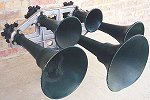Leslie S-5T | |||||
|---|---|---|---|---|---|
 | |||||
S-5T is a shorthand designation for any Leslie 5-chime Supertyfon horn that uses the
#25, 31, 37, 44, and 55 bells (the "T" chord). The actual model designation of a given
horn may have additional prefixes and suffixes as follows. | |||||
 | Rear view of the S-5T-RRO. | ||||
 |
The S-5T was introduced in the early 1950's as a replacement for the S-5D, and competition for the Nathan M5. As with the S-3L, the earliest S-5T's featured bronze power chambers and two-piece bells. The S-5T was a popular horn on Kansas City Southern, Illinois Central, MKT, Norfolk & Western, Frisco, and Chessie System. Santa Fe used the S-5T on most of its passenger diesels. Horn and photo courtesy Brent Lee. | ||||
 |
Front and rear views of an all-bells-forward RS-5T. The RS power chambers
with spiked back caps came about in the 1970's with the goal of making the horns less susceptable
to fouling. RS-5T's tend to sound harsher and less musical than earlier S-5T's. Horn and photos
courtesy Brent Lee. | ||||
 | |||||
Prime Manufacturing Corp. of Oak Creek, WI offered a horn identical to the S-5T, which they called the PM-929. No PM-929's are known to have been produced, however. | |||||
Factory tuning was: 255, 311, 370, 440, and 554 Hz (approximately C,D#,F#,A,C#). | |||||
No large railroads have purchased the S-5T in recent years, but examples may still be found on older Illinois Central, CSX, and KCS locomotives. Norfolk Southern may have a few S-5T's left on former Norfolk & Western units.
Union Pacific's E-units #949 and 951 had RS-5T's as of mid-2000.
| |||||
S-5T sound samples:Norfolk & Western, various locomotives:Sample 1...232kB...10 seconds Sample 2...392kB...18 seconds Sample 3...424kB...19 seconds Sample 4...136kB...6 seconds Sample 5...295kB...13 seconds Union Pacific E-units: Sample 1...157kB...7 seconds Sample 2...399kB...18 seconds Sample 3...324kB...15 seconds CSX, various locomotives: Sample 1...340kB...15 seconds Sample 2...318kB...14 seconds Sample 3...256kB...11 seconds Sample 4...476kB...22 seconds Sample 5...625kB...29 seconds Sample 6...356kB...16 seconds When bad things happen to good horns:
Sample 1...341kB...15 seconds Sample 2...316kB...14 seconds Horns with squealing bells: Sample 1...213kB...9 seconds Sample 2...464kB...21 seconds Sample 3...507kB...23 seconds Sample 4...318kB...14 seconds | |||||
| Prefixes: |
|---|
R=improved horn bells with spiked back caps |
| Suffixes: |
O=some bells have swapped locations on manifold |